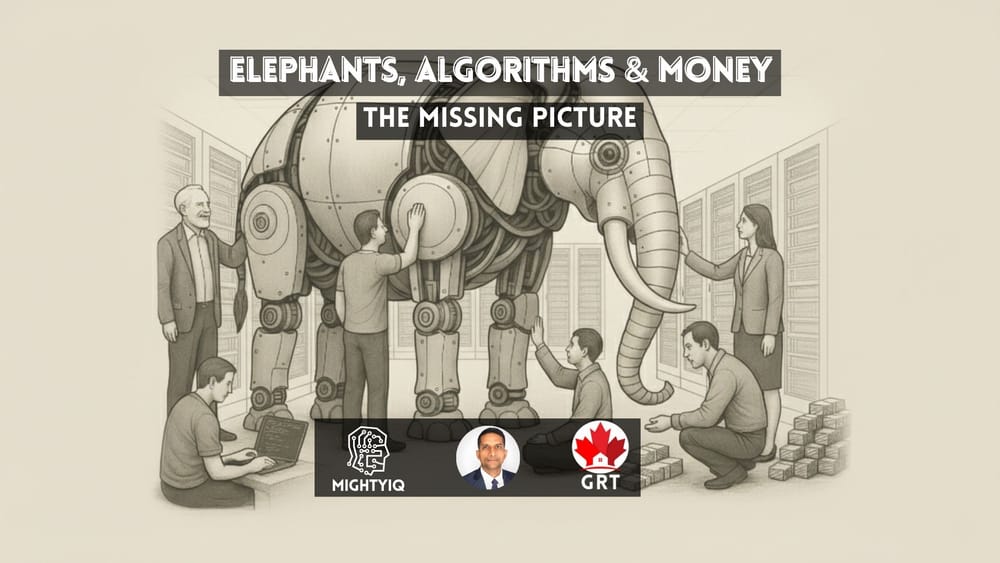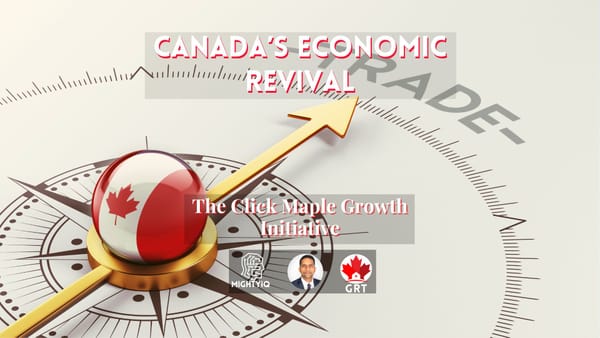Elephants, Algorithms & Money
The Missing Picture
There’s an old Indian parable about six blind men and an elephant.
Each touches a different part and describes what they feel —
a wall, a rope, a spear, a fan, a pillar, a hose.
Each is convinced. Each is wrong.
Because truth, like intelligence, isn’t found in the fragments —
it’s revealed only in the whole.
That parable fits the AI industry today.
Everyone’s trying to define it — investors, engineers, founders, policymakers, and artists —
each touching a different part of the system, each seeing only a fragment.
And like the blind men, each may be right… but only partly.

⚙️ The Bigger Picture
The world is witnessing an AI infrastructure boom unlike anything before.
📈 Sam Altman recently shared that OpenAI expects to end 2025 with $20 B in annualized revenue,
and more than $1.4 T in data-center commitments over the next eight years.
It’s a breathtaking number — but it raises a quiet question:
💭 Are we building for tomorrow’s possibilities, or chasing today’s hype?
AI is powerful, yes — but the realities of compute, regulation, and IP rights are creating a complex mix of ambition and anxiety.
While governments debate national AI reserves and courts redefine ownership,
thousands of startups are building copilots and automation tools — each hoping to ride the wave.
Somewhere between capex and code, the story feels incomplete.
We’re all touching the elephant — but few seem to ask what kind of creature we’re really building.
🎬 James Cameron’s Take on Creation & IP
In his podcast with Andrew Bosworth (Boz), CTO of Meta, filmmaker James Cameron explained why IP law must focus on outputs, not inputs:
“Every artist — every human — is a model. We don’t carry a database of 75 million files; we build models as we live, learning to react and create from experience. That’s why, as Cameron put it, the law should manage AI by its output, not its input.”
That line reframes how creativity and ownership will evolve.
⚖️ The Getty v. Stability AI ruling echoed the same idea — training itself isn’t infringement, but plagiaristic outputs can be.
🚀 For Startups — A Note of Caution
If you’re building in AI, remember: not every problem needs a large model,
and not every product needs deep learning.
💡 My advice:
• 🧮 Mind your compute dependencies — cloud costs scale faster than adoption.
• 🧠 Understand IP ownership — data and outputs define value.
• 🎯 Prioritize clarity over complexity.
• 🧩 Build for endurance, not just hype.
You don’t want to realize later that you spent 💸 100× to achieve 1× — or none at all.
🌱 Beyond Growth Takeaways
💰 1. Scale ≠ Sustainability
AI’s trillion-dollar infrastructure race proves that growth alone doesn’t guarantee value. The next edge lies in scaling responsibly — where investment meets restraint.
⚙️ 2. Innovation Needs Infrastructure — and Insight
Compute power and data centers may fuel AI, but clarity of purpose sustains it. Without balance between build and vision, innovation risks becoming noise.
⚖️ 3. IP Is Shifting from Data to Delivery
As James Cameron noted, it’s the output that defines originality. The future of ownership will depend on accountability, not accumulation.
🚀 4. Startups Must Build for Endurance
In the AI gold rush, compute costs can outpace creativity. Focus on clarity, cash flow, and customer value — not just large models or hype.
🌐 5. Trust Is the Real Competitive Edge
From media to machine learning, credibility still compounds faster than capital. The strongest ecosystems will be built on governance, transparency, and purpose.
💬 What Do You Think?
Are we witnessing disciplined ambition — or trillion-dollar overreach?
And in this race to build intelligence,
are we seeing the whole elephant — or just our part of it?
♻️ Repost if you believe progress isn’t about scale — it’s about seeing the whole picture.
🤝 Let’s Collaborate
I’m a Canada-based entrepreneur and growth strategist working at the intersection of technology, trust, and transformation — helping organizations turn disruption into durable advantage.
Like today’s AI story, I believe the next wave of leaders won’t win by scaling faster, but by seeing the whole picture — where technology, ethics, and execution work in balance.
If you’re exploring how to grow responsibly in the AI era — through better infrastructure, content strategy, or digital ecosystems — let’s connect.
What I Focus On
🌍 Strategic Reinvention — guiding businesses to reposition, refocus, and rediscover their edge in fast-changing, AI-driven markets.
🧠 Digital & Financial Transformation — helping fintechs, SaaS, and tech-driven enterprises align innovation with measurable, sustainable outcomes.
⚙️ Systems That Scale — building intelligent ecosystems that prioritize reliability, resilience, and long-term trust over short-term hype.
How I Help
💡 Technology & Platform Strategy — advising startups and organizations on scaling responsibly within AI, cloud, and embedded systems.
📦 Supply Chain Transparency — leveraging data and automation to bring visibility, traceability, and accountability to global networks.
📺 Media & Content Growth — helping digital media and FAST ventures scale sustainably through clear positioning and strategic distribution.
Across sectors — from technology to media — the strongest organizations aren’t just building intelligence,
they’re building trust.
Because in every transformation, credibility remains the real competitive edge.
🌐 Building something new?
If you’re looking for a reliable hosting provider, I’d recommend DreamHost.
We’ve used it for our client websites for over a decade — it’s fast, secure, and built for creators who want peace of mind.
🔔 Stay Connected
If this story on perspective, resilience, and transformation resonated with you, let’s keep the conversation going.
👉 Subscribe to my newsletter, Beyond Growth Playbook, for insights on strategy, technology, and transformation: iamgrt.kit.com.
⚡Build with Confidence with GRT is a focused space (WhatsApp channel) for founders and professionals seeking clarity, momentum, and practical guidance. Get sharp insights across CPG, digital transformation, AI, global trade, and growth strategy — to move faster and build smarter. https://tinyurl.com/buildGRT


